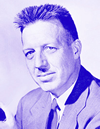Douglas McGregor part 1
Background
Douglas McGregor, an American social psychologist, developed his theory X and theory Y of human motivation at the MIT Sloan School of Management in the 1960s.
It has been used in human resource management, organizational behaviour, and organizational development.
They describe two very different attitudes toward workforce motivation.
McGregor felt that companies followed either one or the other approach.
He was president of Antioch College from 1948 to 1954.
His theories were contained in his book ‘The Human Side of Enterprise’ published in 1960.
More recent studies have questioned the rigidity of McGregor’s model.
They are two opposing perceptions about how people view human behaviour at work and organizational life.
Theory X
In this theory management assumes employees are inherently lazy and will avoid work if they can.
Because of this workers need to be closely supervised and comprehensive systems of controls developed.
A hierarchical structure is needed with a narrow span of control at each level.
According to this theory employees will show little ambition without an enticing incentive program and will avoid responsibility whenever they can.
They may find work distasteful.
Close supervision is required.
According to McGregor, most managers (in the 1960s) tended to subscribe to Theory X, in that they took a rather pessimistic view of their employees.
A Theory X manager believes that his or her employees do not really want to work, that they would rather avoid responsibility and that it is the manager's job to structure the work and energize the employee.
The result of this line of thought is that Theory X managers naturally adopt a more authoritarian style based on the threat of punishment.
Theory Y
In this theory management assumes employees are ambitious, self-motivated, anxious to accept greater responsibility, and exercise self-control and self-direction.
It is believed that employees enjoy their mental and physical work activities.
It is also believed that employees have the desire to be imaginative and creative in their jobs if they are given a chance.
There is an opportunity for greater productivity by giving employees the freedom to be their best.
A Theory Y manager believes that, given the right conditions, most people will want to do well at work and that there is a pool of unused creativity in the workforce.
They believe that the satisfaction of doing a good job is a strong motivation in itself.
A Theory Y manager will try to remove the barriers that prevent workers from fully actualizing their potential.
In general this gave the false impression that Theory X managers were the bad guys and that Theory Y managers are the best.
Abraham Maslow
The existence of Maslow’s ‘hierarchy of needs’ gave credibility to McGregor’s Theory X and Y.
With the publication of the Theory X and Y Maslow’s views on motivation increased in fame.
Business life in the West was sharing a reaction against the 1940's experiences of totalitarianism and the perceived threat of world communism in the 1950's.
McGregor argued that there was nothing wrong or bad about exercising authority or giving instructions.
However, if the Theory X approach for management is less than effective then the alternative Theory Y with more democratic involvement offered more returns than more doses of authority.
Humanistic values were introduced into management thinking.
However, these values reflected managerial efficiency, measurement and control – this holds well with traditional scientific management.
The practice of staff appraisal was an important extension of McGregor's argument.


